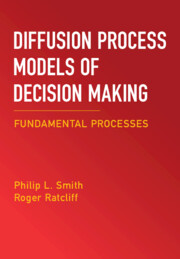Book contents
- Frontmatter
- Dedication
- Contents
- List of Figures
- Preface
- 1 Overview
- 2 Basic Concepts and Data
- 3 Sequential-Sampling Models of Decision Making
- 4 Obtaining Predictions for Diffusion Models
- 5 Empirical Assessment of Sequential-Sampling Models
- 6 Time-Varying Diffusion Models, I. Time Pressure, Urgency, Collapsing Boundaries, and Optimality
- 7 Diffusion Models for Time-Controlled Processing Tasks
- 8 Time-Varying Diffusion Models, II. Detection and Simple RT
- 9 Diffusion Processes Driven by Time-Varying Stimulus Representations in Visual Working Memory
- 10 Neural Diffusion Models, I. Network and Dynamical System Models
- 11 Neural Diffusion Models, II. Poisson Shot Noise and Related Models
- 12 Diffusion Models for Continuous-Outcome Decision Tasks
- 13 Response Confidence
- 14 EZ and Moment Models, Multialternative Decisions, and Expanded Judgment Tasks
- References
- Index
2 - Basic Concepts and Data
Published online by Cambridge University Press: 26 October 2025
- Frontmatter
- Dedication
- Contents
- List of Figures
- Preface
- 1 Overview
- 2 Basic Concepts and Data
- 3 Sequential-Sampling Models of Decision Making
- 4 Obtaining Predictions for Diffusion Models
- 5 Empirical Assessment of Sequential-Sampling Models
- 6 Time-Varying Diffusion Models, I. Time Pressure, Urgency, Collapsing Boundaries, and Optimality
- 7 Diffusion Models for Time-Controlled Processing Tasks
- 8 Time-Varying Diffusion Models, II. Detection and Simple RT
- 9 Diffusion Processes Driven by Time-Varying Stimulus Representations in Visual Working Memory
- 10 Neural Diffusion Models, I. Network and Dynamical System Models
- 11 Neural Diffusion Models, II. Poisson Shot Noise and Related Models
- 12 Diffusion Models for Continuous-Outcome Decision Tasks
- 13 Response Confidence
- 14 EZ and Moment Models, Multialternative Decisions, and Expanded Judgment Tasks
- References
- Index
Summary
Chapter 2 describes the basic regularities in the speed and accuracy of decisions found in a variety of perceptual and cognitive tasks, such as brightness discrimination, orientation discrimination, motion discrimination, lexical decision, and recognition memory. The key data are the ways in which the speed and accuracy of decisions vary with the difficulty of the task and how this interacts with experimental instructions to make fast or accurate decisions. Decision makers can trade off speed against accuracy, as instructed, and the mechanism that allows them to do this is one of the key findings that a model must explain. Other keys findings are the fact that incorrect decisions are typically slower than correct decisions in difficult tasks in which accuracy is stressed, but faster than correct decisions in easy tasks in which speed is stressed and the shapes of the associated response time distributions. The chapter reviews two graphical methods for characterizing how speed and accuracy vary across experimental conditions: the latency-probability plot and the quantile-probability plot. It also highlights regularities in the shapes of response time distributions and the way in which they vary across experimental conditions.
Keywords
Information
- Type
- Chapter
- Information
- Diffusion Process Models of Decision MakingFundamental Processes, pp. 10 - 23Publisher: Cambridge University PressPrint publication year: 2025
